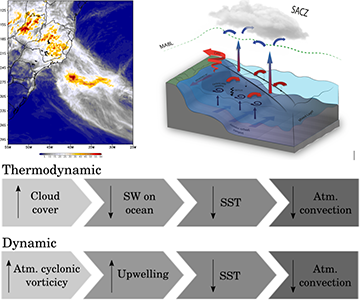Sea surface cooling mechanisms caused by oceanic SACZ episodes at Southwestern Atlantic

A recent study (https://doi.org/10.1007/s00382-022-06195-3) led by Dr Luciano Pezzi, member of the CLIVAR/CliC/SCAR Southern Ocean Region Panel, was published in Climate Dynamics. This work brings a new approach to the study and understanding of the oceanic surface cooling that the oceanic South Atlantic Convergence Zone (SACZ) causes, concerning air-sea interaction processes. Two mechanisms based on dynamic and thermodynamic of ocean surface cooling are studied. Both mechanisms are present on this sea surface cooling. Model results indicate that surface atmospheric circulation and the presence of an extensive cloud cover band over the SWA promote sea surface cooling via a combined effect of dynamic and thermodynamic mechanisms, which are of the same order of magnitude. The sea surface temperature (SST) decreases in regions underneath oceanic SACZ positions, near Southeast Brazilian coast, in the South Brazil Bight (SBB) and offshore. This cooling is the result of a complex combination of factors caused by the decrease of solar shortwave radiation reaching the sea surface and the reduction of horizontal heat advection in the Brazil Current (BC) region. The weakened southward BC and adjacent offshore region heat advection seems to be associated with the surface atmospheric circulation caused by oceanic SACZ episodes, which rotate the surface wind and strengthen cyclonic oceanic mesoscale eddy. Another singular feature found in this study is the presence of an atmospheric cyclonic vortex Southwest of the SACZ (CVSS), both at the surface and aloft at 850 hPa near 24°S and 45°W. This feature so far has not been discussed much in the literature. Therefore, the changes produced in the oceanic dynamics by these SACZ events may be important to many areas of scientific and applied climate research. For example, episodes of oceanic SACZ may influence the pathways of pollutants as well as fish larvae dispersion in the region.











Add new comment